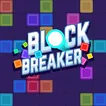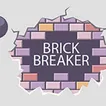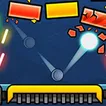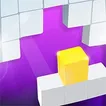






































Brick Breaker Games: The Classic Arcade Experience Online
Brick Breaker games have long been a beloved staple in the gaming world, tracing their lineage back to the luminous arcades of the past. These games are deceptively simple: players maneuver a paddle to bounce a ball towards a formation of bricks, with the goal of breaking them all to progress to the next level. This basic premise has endured the test of time, proving that a strong core mechanic can be the foundation of enduring appeal.
The transition from the physical arcade cabinets to the digital realm has been seamless, with the essence of Brick Breaker games remaining intact. Online versions have made this classic genre accessible to a broader audience, ensuring that the thrill of chasing high scores isn’t confined to the corners of dimly lit gaming halls, but can be experienced anywhere at any time.
Despite the evolution of graphics and the introduction of various themes and power-ups, the heart of Brick Breaker games remains the same. The satisfaction of clearing a challenging level or achieving a new high score is as potent on a smartphone or computer screen as it was on the arcade machines of yore.
The online incarnation of Brick Breaker games has also introduced new dynamics to the genre. With the advent of global leaderboards and social media integration, players are no longer competing against just the machine but against the world. This competitive edge has breathed new life into the genre, ensuring that each brick smashed is not just a personal victory, but a communal triumph.
In essence, the allure of Brick Breaker games lies in their simplicity and the immediate feedback loop of action and reward. As they continue to captivate players online, they stand as a testament to the timeless nature of good game design, where the simplest concepts often lead to the most enduring experiences.
Brick Breaker Online: Mastering Strategy and Reflexes
Brick Breaker games are not just about the relentless destruction of bricks; they are a dance of strategy and reflexes, a test of anticipation and precision. The core mechanics are simple, yet mastering the game requires a nuanced understanding of angles, momentum, and timing. As the ball accelerates and the patterns of bricks become more complex, players must think several moves ahead, planning their shots to maximize damage and avoid getting caught off guard.
The evolution of game controls has had a profound impact on Brick Breaker gameplay. The tactile feedback of arcade buttons gave way to the smooth glide of a mouse or the swipe of a finger on touch screens, offering a more intuitive and direct control over the paddle. This transition has allowed for more fluid and responsive movements, which are essential in higher levels where the margin for error is razor-thin.
Despite the change in interfaces, the essence of the challenge remains: it’s a ballet of the player’s paddle against the relentless descent of bricks. Success in Brick Breaker hinges on the ability to balance reactive gameplay with strategic foresight. Power-ups and special bricks introduce additional layers of strategy, compelling players to decide when to prioritize certain targets or when to conserve resources for critical moments.
The satisfaction derived from a well-executed plan that culminates in the clearing of a tough screen is immense. It’s this blend of mental and physical agility that keeps players returning to Brick Breaker games, eager to refine their strategies and sharpen their reflexes. As they navigate through levels, players develop a rhythm and a personal style that is as unique as it is effective, turning what appears to be a straightforward game into a deeply personalized challenge.
The Cultural and Community Impact of Brick Breaker Games
Brick Breaker games have transcended their role as mere pastimes to become cultural icons in the gaming industry. Their influence extends beyond their genre, inspiring a variety of game designs that incorporate their simple yet compelling mechanics. The games have a universal appeal, resonating with a diverse audience ranging from casual players looking for a quick diversion to hardcore enthusiasts dedicated to conquering the most challenging levels.
The community that has formed around Brick Breaker games is a testament to their impact. Forums and online groups dedicated to sharing tips, strategies, and personal achievements have fostered a sense of camaraderie among players. The competitive spirit is alive and well within these communities, with leaderboards serving as battlegrounds where players vie for supremacy, pushing the limits of what is possible within the game’s parameters.
Social sharing features have further solidified Brick Breaker games as a shared social experience. Players celebrate high scores and memorable moments by posting them on social media, inviting friends and followers to join in the challenge. This has created a feedback loop that not only keeps the community engaged but also attracts new players, drawn by the stories and achievements of others.
The cultural footprint of Brick Breaker games is significant, with their core gameplay mechanics becoming part of the collective gaming consciousness. They have proven that a game doesn’t need complex narratives or cutting-edge graphics to make a lasting impact. Instead, the simple joy of breaking bricks has united players across the globe, creating a legacy that continues to influence the gaming landscape.
The Future of Brick Breaker Games: Innovation and Technology
As we peer into the horizon of gaming, Brick Breaker games stand poised to embrace innovation and technology while retaining their classic appeal. The potential integration of augmented reality (AR) could transform the way we interact with these games, projecting bricks and paddles into our physical space and adding a new layer of immersion. Imagine swiping through the air with your hand to control the paddle, turning your entire room into a dynamic game board.
Advancements in haptic feedback could also elevate the tactile sensation of gameplay, providing a more engaging and realistic experience. The feeling of the ball striking the paddle or the shudder of a brick breaking could be felt in the palms of players’ hands, deepening the connection between action and reaction.
Artificial intelligence (AI) might introduce adaptive difficulty levels, crafting personalized challenges that evolve based on a player’s skill, ensuring that the game remains challenging and rewarding for both novices and experts alike. This could lead to a more tailored gaming experience that grows with the player.
Despite these potential advancements, the core appeal of Brick Breaker games is likely to remain untouched. The simplicity of their design and the satisfaction of breaking bricks are timeless elements that continue to resonate with players. As technology progresses, these games have the unique opportunity to blend the old with the new, offering a familiar gameplay experience enhanced by the capabilities of modern technology.
The future of Brick Breaker games is bright, with the promise of innovation that respects the genre’s heritage while propelling it into new realms of interactive entertainment. The enduring popularity of these games suggests that no matter how much they evolve, they will continue to captivate and challenge players for generations to come.